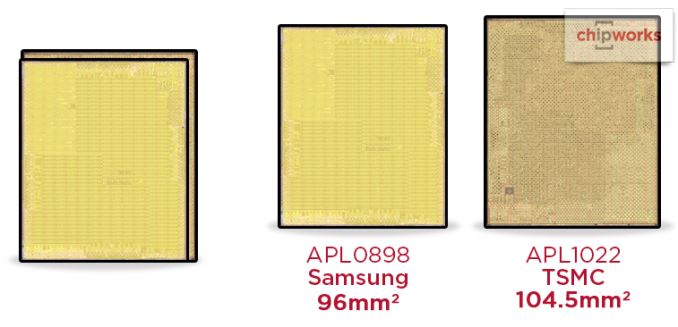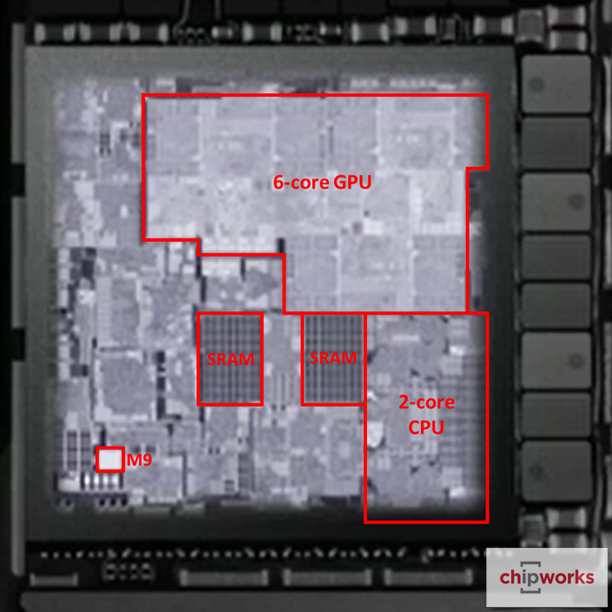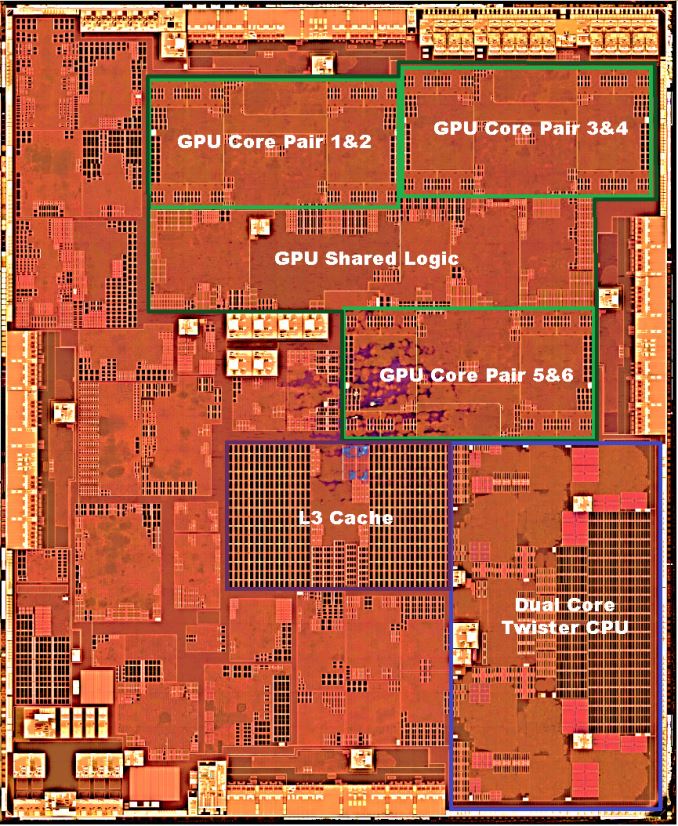The Apple iPhone 6s and iPhone 6s Plus Review
by Ryan Smith & Joshua Ho on November 2, 2015 8:00 AM EST- Posted in
- Smartphones
- Apple
- Mobile
- SoCs
- iPhone 6s
- iPhone 6s Plus
Dual Sourcing A9: Two for the Price of Two
Perhaps more remarkable than the fact that the A9 is built using a FinFET process however is who it is being built by. For the first time Apple is dual sourcing the SoC – rather than using TSMC or Samsung exclusively, they are using both.
Broadly speaking, dual sourcing is a practice that has fallen out of style as the number of contract semiconductor manufacturers has dwindled and the cost of chip production has gone up. Because each manufacturer has its own rules and own best practices, to dual source a chip involves designing it twice, once for each manufacturer. This has made the cost of dual sourcing increase over time, and consequently dual sourcing falling out of fashion.
This of course is a big part of what makes Apple’s decision to dual source so unexpected. Apple is taking a much bigger gamble this time around by dual sourcing than they have on past SoCs where it was produced by a single manufacturer (be it TSMC or Samsung). Dual sourcing means that Apple’s costs to tape-out and bring-up A9 have very nearly doubled; they have to tape-out each version of the A9 for the respective fab’s rulesets, and then they have to go through the bring-up process with each in order to dial-in the yields and clockspeeds. They at least get to reuse the underlying architecture (e.g. Twister CPU and their PowerVR GPU), but actually creating a chip design for each fab is a significant part of the development costs for A9.

Samsung vs. TSMC A9 Die Size (Image Courtesy Chipworks)
The end result then is two similar but not quite equal chips that are produced by TSMC and Samsung respectively. Both are A9s, both feature the same CPU, GPU, memory interface, and all of the other bits that make up an A9. But each is produced at a different fab, according to the rules of that fab.
One of the immediate ramifications of dual sourcing is that the die sizes of the A9s are different. The A9 produced by Samsung on their 14nm FinFET Process is the smaller of the two, at 96mm2. Meanwhile the A9 produced on TSMC’s 16nm FinFET process is 104.5mm2, making it about 9% larger. Though not an immense difference in size (and not that we’d expect otherwise) there are tradeoffs to be had. With all other things held equal, the larger TSMC die would produce fewer complete dies per 300mm wafer, and any given die is more likely to have an imperfection since there are fewer dies for the same number of imperfections. This gives the Samsung A9 a slight edge in manufacturing thanks to its better density, however it’s equally important to note that in the real world there are a number of factors at play here, including manufacturing yields at each fab and how much each fab is charging Apple, so while the Samsung A9 is the smaller A9 it isn’t necessarily the cheaper A9.
The bigger question on many minds is whether there’s a performance difference between the two A9s. We wrote a bit on the subject a few weeks back, and the short answer is that it’s very difficult to tell. Due to chip quality being a distribution no two phones utilizing the same A9 are the same, and that means just comparing any two phones can’t tell us the whole story. Ultimately what one needs is a large number of phones to find the distribution, the median of that distribution, and how the medians compare. This is something that if done perfectly would require thousands of phones, and is really only possible for Apple or the competitive analysis teams at their well-funded competitors.

Apple A9 Die Shots (Image Courtesy Chipworks Teardown Report)
At this point then we don’t have anything new to add to the discussion – we don’t have enough data – though it is still a matter we are working on. Sometimes the best thing we can do is say is when we don’t have enough information, rather than extrapolating too much from too little information. I will note however that it’s ultimately in Apple’s best interests for the A9s to be as similar as possible, and there are steps they can take to ensure that, particularly in selecting which chips they will use.

Current A9 Chip Manufacturer Distribution (Image Courtesy Hiraku)
Meanwhile looking at the data collected by iOS developer Hiraku’s CPU Identifier project, it’s interesting to note that of the 250K+ phones sampled so far, the Samsung A9 is in 63% of those phones, giving us a Samsung-to-TSMC ratio of nearly 2-to-1. This survey should not be considered the final word in the ratio between the two A9s since it can change over time and an opt-in survey of this fashion has an inherent self-selection bias, but with so many results it should be a reasonably accurate summary of the current situation.
What remains to be seen – and likely never to be answered outside the walls of One Infinite Loop – is why Apple dual sourced in the first place. We can certainly speculate on reasons they would do this – yield issues at a fab, a desire to avoid putting all of their eggs in one basket and giving one fab too much power, or even just wanting to ramp up A9 production quickly by doubling the number of fabs working on it. What is apparent however is that with Apple selling 48M iPhones in Q3’15 (note that the majority of these were not 6ses), A9 is a uniquely good candidate for dual sourcing. Apple sells enough iPhones that their large pile of cash aside they can absorb the cost of dual sourcing by spreading out the costs over tens of millions of high-margin chips, and if yields/supply were a factor in this decision then that’s all the more reason to dual source. This in turn makes me wonder if we’ll see Apple continue this strategy given their enormous volume, or if this was a one-time event due to the early nature of FinFET, leading to them settling on a single fab for the iPhone 7 launch.
Die Size: Hitting the Sweet Spot
Finally, before jumping into our discussion of the A9’s CPU and GPU, let’s talk about A9’s die size in a historical context. Unlike the transition from A7 to A8, Apple doesn’t get the advantage of a substantial transistor density improvement going from A8 to A9. To use TSMC as an example here (since they produced A8), their 16nm FinFET process is advertised as having 2x the density as their 28nm process, however compared to that same 28nm process their 20nm process had a 1.9x density advantage. In other words, the transition from 20nm HKMG planar to 16nm FinFET does not bring with it the same kind of density improvements we’ve seen in the last few generations.
In fact the only other time Apple has not had the advantage of a density improvement is the transition from A4 to A5, which saw Apple’s die sizes transition from what remains their smallest die to their largest die, all in a single generation. For A9 then Apple has to work smarter, as they can’t add a large number of transistors relative to A8 without ballooning A9’s die size outside of Apple’s sweet spot (and harming chip yields at the same time).
| Apple SoC Evolution | |||
| Die Size | Transistors | Process | |
| A5 | 122m2 | <1B | 45nm |
| A6 | 97mm2 | <1B | 32nm |
| A7 | 102mm2 | >1B | 28nm |
| A8 | 89mm2 | ~2B | 20nm |
| A9 | 96mm2/104.5mm2 | >2B | 14nm/16nm |
Consequently the A9s that we’re getting are surprisingly conservative. The TSMC A9 is 104.5mm2, some 17% larger than the TSMC A8. Meanwhile the Samsung A9 is the smaller of the two at 96mm2. The TSMC A9 is now Apple’s second-largest non-X SoC, but just barely so; it’s only 2.5mm2 larger than the A7. Otherwise with an average die size of 100mm2, this puts the A9 at the upper-bounds of Apple’s sweet spot.
Yet despite the limited gains in transistor density versus A8, Apple has managed to “bulk up” their SoC design by quite a bit. We’ll go over this in greater detail on the following pages, but of particular note is that Apple is now implementing what we believe to be a 6 core PowerVR GPU design, and Apple has significantly increased both the L2 and L3 cache sizes. Coupled with this is the jump to LPDDR4 (requiring more complex memory controllers) and numerous smaller improvements we’ll likely never learn about. The number of CPU cores remains unchanged at 2 however.

Chipworks' Initial Layout Analysis (Image Courtey Chipworks)

My Layout Analysis For A9 (Die Shot Courtesy Chipworks)
On a final note, now that we have die shots of both A9s from Chipworks, I must tip my hat towards Apple for releasing an accurate die shot of what we now know is the Samsung A9 in their iPhone 6s presentation. Up until now Apple has never released their own die shot of their SoCs, and in fact first-party die shots are becoming increasingly rare as a whole in the semiconductor industry. Consequently I had expected that Apple’s die shot was a fake, only to be far more impressed that it’s real. Furthermore despite the low resolution of the shot, Apple’s false color and contrast enhancements make it surprisingly clear where the CPU and GPU blocks are, and how many of each there are. This is a level of contrast that even the Chipworks shots can’t quite match this time around.











531 Comments
View All Comments
Gigaplex - Monday, November 2, 2015 - link
On the other hand, Jim Keller no longer works at Apple. He is the mastermind behind Apples architecture.zeeBomb - Monday, November 2, 2015 - link
Oh man...when was his departure? Who's the lead now?NBvdB - Tuesday, November 3, 2015 - link
Jim Keller left in 2012. That hasn't seemed to stop Apple from continuing to make huge steps forward since then. Current Chief CPU design is Gerard Williams.iwod - Monday, November 2, 2015 - link
Let state a few things.Next SoC aka A10 will not have 12MB Cache. And not 8 Core GPU. Because both of this assumption increase die size and therefore what you are suggesting is Apple jumping to 10nm. Which isn't available to tape out until late 2016 and ready for 2017 iPhone.
The A10 is pretty much set, going to be produced by TSMC 16nm FFC, current A9 is 16nm FF+. 16nm FFC is likely to get 10 - 15% performance / watt while being cheaper to produce. Assuming Apple could further tweak its GPU and CPU, so we really should only expect 20% improvement in next iteration. Which is still a very very good number.
The A11, which will get the TSMC 10nm die shrink, will likely get another major architecture change, so the Quad Core, or 2 Core SMT as well as 8 core GPU design will likely end up there. The 8 Core GPU as well as the frequency improvement with 10nm will / should force Apple to upgrade their Memory bandwidth. The industry is still trying to figure out where to go next. LPDDR5 , which is not even a standard yet has been bought up recently, since Wide I/O 2 still has its problem and challenges. I am not sure if this can be solved in time for A11, if not Apple will likely just choose a faster LPDDR4 instead.
I will love to see a comparison between Apple SoC and Intel Skylake. But I think the A9x with 4 Core will be a better comparison to Intel 2C4T design. Let's hope Anandtech will do that in their iPad Pro review.
zeeBomb - Tuesday, November 3, 2015 - link
I have a feeling though apple can do it. A 10nm process...mobile tech sure evolved nowadays.Alexey291 - Tuesday, November 3, 2015 - link
They have nothing to do with actual manufacturing process. Neither does manufacturing process have anything to do with mobile tech.On the whole your comment made my eyes bleed.
paulwb - Monday, November 2, 2015 - link
well deserved editors choice for the 6s amazed to see that the article didnt stress enough that it was the hardware advancements done by the android OEM that pushed apple to fight back with these high specs and full feature S versions...loved the reviewKevin G - Monday, November 2, 2015 - link
Typo:"In order to test how this storage solution performs, we Eric Patno’s storage test which allows for a simple storage test comparable to AndroBench 3.6."
I think you accidentally the word 'used' in that sentence (unless Eric Patno is a verb).
vastac13 - Monday, November 2, 2015 - link
Now, we need the Nexus 6p in-depth review from Anandtech and hopefully we can see a Gold Choice award from Android CampBrandon Chester - Monday, November 2, 2015 - link
Neither Nexus device does anything to meaningfully move the smartphone industry forward. There's a reason the 6s, and prior to it the HTC One (M7) are the devices that received it.